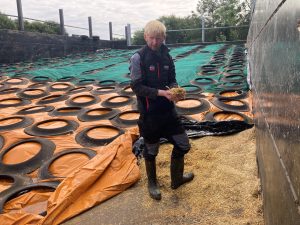Having used Maxammon since its launch in 2011 to treat his grain, Scott Murchie, a dairy farmer at Gullielands Farm, Annan, Dumfriesshire made a significant change back in 2016 and decided to harvest his cereals as wholecrop.
At the time it took Scott a bit of convincing and he had said then “It almost goes against the grain to take a crop to combine stage and then put it through the chopper but we have definitely seen the advantages. It’s not just the cost cutting; the cow health has definitely improved, overall performance is better and we have found it simplifies systems on the farm.”
“How I describe it, is that Maxammon wholecrop has the dry matter of straw, with the energy and protein of a good silage combined with the starch levels of maize. It’s an ideal combination.”
Eight years on and now in 2024, Scott has continued to harvest his cereals as wholecrop using Maxammon.
When asked what it was about Maxammon that he had continued to use it, Scott gave a number of reasons including convenience, feed cost, nutrition, production, fertility and cow longevity.
“One of the key reasons for using Maxammon is the convenience, in terms of getting the fields cleared quickly. It is also a very stable product – as long as you keep it dry. We can take out two week’s worth at a time, so it means we aren’t opening and closing the pit on a daily basis.
For efficiency of time and nutrition, it simplifies systems on farm and it suits our feeding style, complementing multi cuts of silage. To treat with Maxammon, the cost/tonne looks expensive but looking at the dry matter/tonne, it is a low cost feed, even comparing it to moist feeds and silage, it works out much better value.
We have definitely seen benefits in our cow health and we see it in the cow longevity figures too. We have better milk solids and milk quality and the cell counts are down, Maxammon is definitely a contributor within the whole management of the herd.”
“I like the one-pass system, the field is cleared, there’s no baling or bruising to do and it all works well. Cracking the grain is crucial and when we started, we had a few teething problems. We have a good understanding with our contractor so these issues were swiftly ironed out in the first year. We’ve never looked back.” continues Scott.
“We could feed more but we work with the acreage that we have and the pit lasts us the year. We grow 130-140 acres of barley split 1/3 winter to 2/3 spring yielding 5-5.5 tonnes/acre. When we are treating, we add an extra 10kg urea per tonne to further lift the protein.
We take five to six cuts of silage aiming to maximise milk production from forage. We then spread the first cut silage across the year as it tends to be the best and this gives the ration consistency for 12 months of the year. The Maxammon wholecrop complements the leafy high energy silage and opens up the ration.
We are feeding a high and a low ration with 5kg and 3.5kg Maxammon wholecrop being fed respectively with silage, protein blend, draff and molasses making up the rest of the ration.” says Scott.

“Ultimately farmers need to get the best return from their inputs, and treating the wholecrop with Maxammon allows them to maximise on homegrown forage and cereals, reducing the need for additional protein inputs. It also helps the overall wellbeing of the cattle, helping to reduce acidosis risk and promote rumen health.” says Arol Hyslop, Harbro dairy specialist.
“Scott is a great advocate of using Maxammon and it speaks volumes that he has been using it for a considerable number of years now. When harvesting his wholecrop, his experience coupled with his attention to detail ensures he is producing a high quality feed (see 2023 analysis below). The herd performance that Maxammon wholecrop is helping him to achieve illustrates just how well it works when done properly.” added Arol.
Maxammon Wholecrop Analysis 2023
| Dry Matter | 74% |
| Protein | 17% |
| ME | 12.4 |
| Starch | 35% |
| pH | 9.0 |
Cows are averaging 11,500 litres with butterfat at 4.38% and protein at 3.38% based on a 12 month rolling average. On fertility, the herd is currently running at a pregnancy rate of 36% and conception of 57%.
“That’s good going, I’m very happy with that.” says Scott
Since 2017, Scott has increased the number of milking cows, from 310 up to 370 with a target of 400. “The aim is always to increase efficiency and we plan to put up another shed to accommodate the increased numbers and achieve this.”
“We try and do what we do better.” says Scott. “We are currently looking at the grouping of heifers and improving the integration of maiden heifers into the herd.”
They no longer finish black and white bulls and now use sexed semen on the cows, so running at 30% going to black and white sexed semen and the remainder to Aberdeen Angus. The heifers are 20% to Aberdeen Angus and 80% to black and whites.
“Using genomics, we are trying to breed off the top end of the herd. We are currently running at a 28% replacement rate, aiming to maintain that as any excess ties up capital. Everything else goes to the Aberdeen Angus. These calves go to a rearer at four to five weeks old and that’s the best margin we can get for them.
This allows us to prioritise replacements and improve what we do, where we can. The devil is in the detail and we scrutinise everything we do. Cow longevity is a big focus for us.”
